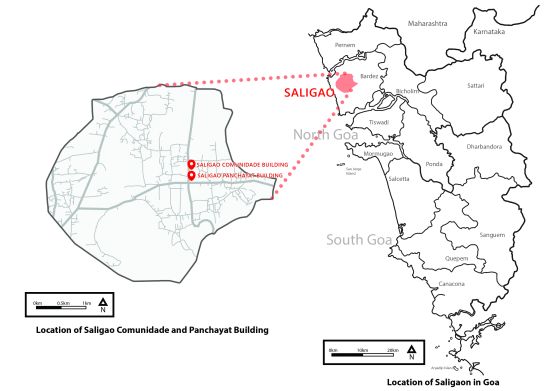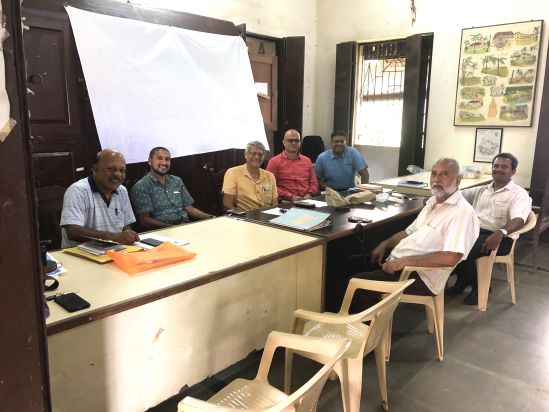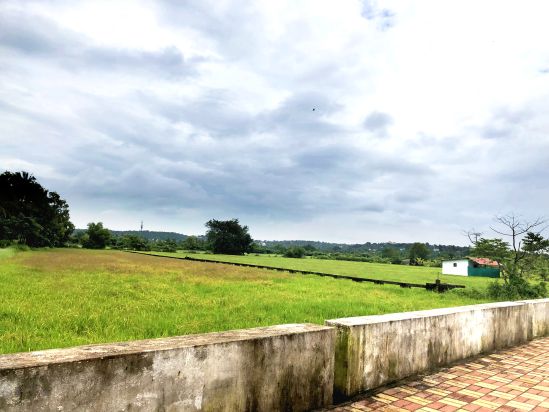The Saligao Comunidade

The Saligao Comunidade
Saligao is a census town located in the Bardez Taluka (a local administrative unit), north of Goa. It is surrounded by the villages of Guirim, Porvorim, Parra, Sangolda, Candolim, Pilerne, Nagoa and Calangute. The town has an active and functioning Comunidade. To conclude the series, this blog post gives a gist of the functioning of the Saligao Comunidade, based on interviews with its committee members.
There are two origin myths of Saligao. According to one - the “Saraswati river disappeared due to tectonic disturbances, impacting its tributaries”(Aggarwal, 2019). Without this mythical holy river, many settlers were forced to move to find a new home. The settlers travelled across India and some of them ended up settling in what is known today as Saligao. It is believed that these settlers brought the sal tree’s sapling along with them and planted it here to remember their homeland. Another take is that among the many different varieties of rice that were grown in the area, they named the village Saligao after the popular Sal variety of rice.
As mentioned in the previous blog posts, the Comunidade System had existed all across India but had survived in Goa since the Portuguese decided to retain it. Before the Portuguese regime, the Comunidades were responsible for the village and received contributions for protecting the village and land. Later, it was reduced to an agricultural society, where the land rested with the commons and rights of use were auctioned every three years. This ensured that the Comunidades got the best price for the uses of the common lands. Every gaunkar would get the opportunity to work on a different piece of land each year, allowing the members to not only take care of the land that they were using but also look after the whole of the village commons.
Today, the Saligao Comunidade functions from an office located in Muddavaddi, Saligao. The Comunidade lands are mostly used for agriculture. Some of the products include paddy, nachni, beans, sugar cane and other local vegetables. The Comunidade has over 650 registered gaunkars who work together to make decisions related to the Comunidade lands. Though the Comunidade has no hierarchy, they do have a management committee comprising of a president, an attorney and a treasurer. These are all volunteer positions. Each of these three members has its own responsibilities, as mentioned below:
| Sr.No | Designation | Responsibilities |
|---|---|---|
| 1 | President |
Overseas the meetings. Makes sure everything is in order. |
| 2 | Attorney |
Works on legal tenures. Handle Auctions. Acts as a secretary. |
| 3 | Treasurer |
Manages the Finances. |
| 4 | Gaunkars | Member of the Comunidades responsible for decision making. |
Membership to the Comunidade is received through male lineage. The member must be a biological descendant and cannot be adopted. This thought process has considerably changed with the current times, and many Comunidades have taken different initiatives to include women in the Comunidade. Earlier, women were not allowed to be a part of the Comunidade due to the Hindu tradition, where if they were married to a person from a different village, they would have to leave for another village, creating challenges within the Comunidade. Today, with changing times, regulations are also changing. In Saligao, women are allowed to attend Comunidade meetings, but they can’t quite voice their opinions unless they are requested to. In Calangute, women are allowed to be shareholders. In Nagoa, the attorney of the Comunidade is a woman. Nowadays, Comunidades are planning on enabling women to receive zones if they are unmarried widows or the only surviving dependent of a gaunkar.
In general, Comunidades do not allow outsiders to participate in the Comunidade meetings and decision-making processes. But they are welcomed as guests if they need to rent the Comunidade property. In the case of Mapusa, there isn't any agriculture taking place, and the Comunidade Property is rented out for commercial use. Saligao’s Communidade lands are not rented out as they are still used for agriculture. The Comunidade has already faced consequences of existing loopholes in regulations and leading to privatization.
The Saligao Comunidade performs two main tasks: Proving license for use of lands and the upkeep of the Comunidade lands. They also work cordially hand in hand with different government authorities. This can be seen in the Saligao Comunidade-Government Afforestation Project, which was carried out nearly 30 years ago and involved the Saligao Comunidade and the Forest Department working together for the Social Forestry Program. The government assisted in replacing the earlier planted Acacia trees with native fruit-bearing trees like mangoes, jamuns, amla, and even other trees like banyans. The goal was to create a sustainable community garden that would be fruitful for future generations. Because of this initiative, there was an increase in groundwater tables. People also began water harvesting. The entire coastal belt received water from Saligao, which had previously been water-scarce. Both the Saligao Comunidade and the Saligao Panchayath collaborate well and seek each other's permission before undertaking any tasks that affect the other.
The Agricultural Tenancy Act brought in a lot of changes, as mentioned in the previous blog posts. The Saligao Comunidade owns approximately 170 hectares of Comunidade land, of which 40 hectares belong to the tenants who are considered deemed owners. Hence, the Saligao Comunidade owns only 130 hectares of land. And as mentioned earlier, such privatisation has led to the construction of a few disputed structures.
According to the Management Committee, change is necessary in order to keep up with evolving needs. The Code of Comunidade was laid out when society was still agrarian-based. The land could only be used for agriculture and wasn't permitted to cater to other small-scale industries, animal husbandry, or other activities that align with agriculture. Today, the total quantum of land that the Comunidade members can give away is only 400 sqm. The Comunidade would be able to achieve financial independence if the government gave them freedom in terms of obtaining approval to establish businesses, agro-industries, and community centres. It will provide the Gaunkars with employment opportunities, to pursue new skills or to set up a business. Gaunkars can use auctioned land to set up temporary structures that can be dismantled once their course has run its time and the depreciated value can be considered.
Key People who contributed to the Case Study
| Sr. No. | Name | Designation |
| 1 | Desmond Da Costa | President, Saligao Communidade |
| 2 | Ashley Delaney | Attorney, Saligao Communidade |
| 3 | Eric Fernandes | Treasurer, Saligao Communidade |
| 4 | Ar Dean D’Cruz | Gaunkar (Saligao Comunidade Member) and Principle Architect (Mozaic) |
| 5 | Ar Brandon Joseph | Junior Architect, Mozaic |
Bibliography
Aggarwal, Mayank. 2019. Review of Bringing Back the Ancient Saraswati River. Mongabay. July 19, 2019. https://india.mongabay.com/2019/07/upcoming-elections-in-haryana-boost-efforts-to-revive-the-ancient-saraswati-river/.








